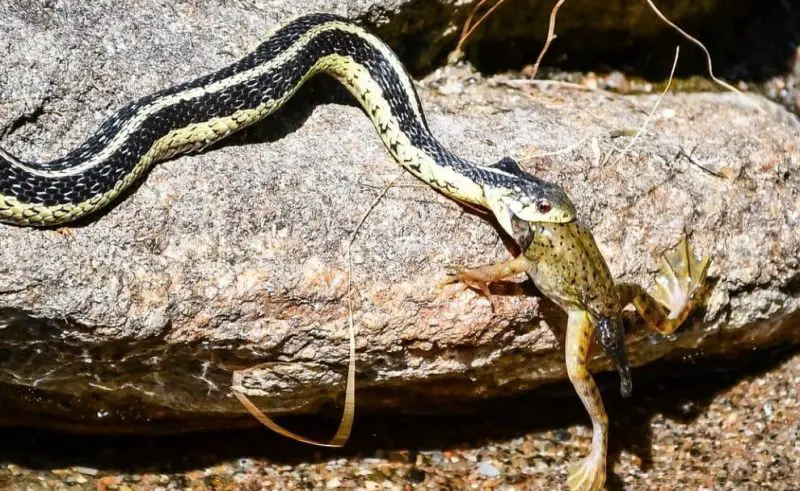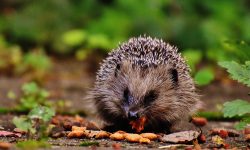Garter snakes are some of the most adaptable and widespread reptiles across North America. They thrive in forests, fields, wetlands, and even suburban areas, thanks to their extremely flexible diet. Unlike many snakes that rely heavily on rodents, garter snakes eat a wide variety of foods, allowing them to stay healthy and active throughout the year.
Their slender bodies, sharp senses, and quick reflexes help them hunt efficiently on land and in shallow water. Whether they’re searching under logs, moving through grass, or prowling along pond edges, garter snakes have countless opportunities to find prey. This diverse feeding behavior also contributes significantly to controlling insect and amphibian populations in their ecosystems.
Understanding what garter snakes eat not only helps researchers and wildlife enthusiasts but also benefits anyone who keeps them as pets or encounters them in gardens. The more balanced and natural their diet is, the healthier and more active they become. Below is a complete guide to the foods that keep garter snakes thriving in the wild and in captivity.
Understanding the Garter Snake Diet

Garter Snakes as Opportunistic Hunters
Garter snakes are opportunistic feeders, meaning they eat whatever prey is most available depending on the season and habitat. They prefer live, moving animals, using their quick-striking behavior and mild venom-like saliva to subdue prey. Their small size allows them to hunt in tight spaces where larger predators cannot reach.
This opportunistic nature makes their diet highly adaptable. In wet habitats, they eat more amphibians and fish. In dry grasslands, they rely more on insects, earthworms, and small mammals. Their ability to adjust food sources is a major factor in their survival success across different climates.
How They Hunt and Consume Prey
Garter snakes use a combination of smell, tongue flicking, and heat sensitivity to track food. Once they detect movement, they strike quickly and swallow prey whole. Their flexible jaws allow them to consume animals larger than their head, although still much smaller than those eaten by larger snake species.
They do not constrict prey like many other snakes. Instead, they rely on speed, jaw grip, and mildly toxic saliva to immobilize animals. This efficient hunting method makes them well-suited for fast-moving environments like streams and dense grass.
When Garter Snakes Eat
Garter snakes feed more frequently than many reptiles because their prey items tend to be small. Younger snakes may eat every couple of days, while adults often feed every three to seven days depending on temperature and prey abundance.
They are most active during warm daylight hours, especially in spring and summer. Cooler weather reduces their appetite, and during winter brumation they eat nothing at all.
20 Foods Garter Snakes Love the Most
1. Earthworms
Earthworms are one of the most common foods for garter snakes, especially juveniles. Their soft bodies make them easy to swallow and digest, even for small snakes. Worms are abundant in gardens, forests, and wetlands, giving garter snakes a reliable food source.
The high moisture content of worms keeps garter snakes hydrated while providing steady protein for growth. Their wriggling movement also triggers the snake’s hunting instincts. Because of their availability, worms often form the bulk of a young garter snake’s diet.
In captivity, earthworms are widely used as a staple food, though they should be varied with other prey for balanced nutrition.
2. Slugs
Slugs are a natural prey item for garter snakes. Their slow movement makes them easy to catch, and their soft texture is ideal for small snakes learning to hunt. In damp environments, slugs become an important seasonal food source.
Slugs provide hydration and moderate protein, helping snakes build energy reserves. Garter snakes often find them under rocks, logs, or moist leaf litter. Their availability increases during rainy seasons, giving snakes regular access to easy meals.
While nutritious, slugs should be varied with other foods to prevent an overly mucus-heavy diet.
3. Snails
Snails are another favorite food, especially in gardens and woodland edges. Garter snakes swallow them whole, shell included, relying on strong stomach acids to break down the calcium-rich casing.
Eating snails provides important minerals that support bone strength and overall health. Juvenile snakes often target smaller snails with thinner shells for easier digestion. Snail-rich habitats attract garter snakes due to the abundance of slow-moving prey.
In the wild, snails help snakes survive periods with fewer insects or amphibians.
4. Small Fish
Garter snakes living near ponds, streams, or wetlands frequently hunt small fish such as minnows, guppies, and mosquito fish. They use their speed and agility in shallow water to grab fish near the surface.
Fish provide high-quality protein and healthy fats, fueling the snake’s growth and movement. Their slippery bodies make them exciting live prey that stimulates natural hunting behavior. Many garter snake species are excellent swimmers, making fish a regular part of their diet.
In captivity, feeder fish can be offered occasionally but should not be the only food source.
5. Tadpoles
Tadpoles are abundant in spring and early summer, providing young garter snakes with a perfect prey item. Soft-bodied and slow-moving, tadpoles are easy to catch and digest.
Their high moisture content keeps snakes hydrated, while their mild flavor encourages young snakes to feed consistently. Garter snakes often hunt around shallow pools where tadpoles cluster in groups.
As tadpoles grow into froglets, they continue to serve as valuable prey for snakes of all sizes.
6. Frogs
Adult frogs are a major food source for many garter snake species. Snakes strike quickly, grabbing a frog before it leaps away. Frogs provide rich protein and essential nutrients for muscle development.
Wetland garter snakes depend heavily on frogs during warm months. Larger snakes tackle adult frogs, while juveniles focus on smaller individuals. Frogs’ strong legs and agility make them challenging prey, showcasing the snake’s impressive hunting skill.
This predator-prey relationship helps maintain balance in amphibian populations.
7. Toads
Some garter snakes specialize in eating toads, even though toads produce toxins. These snakes have evolved partial resistance to toad venom, allowing them to consume species that other predators avoid.
Toads offer substantial nutrition due to their size and body weight. Snakes usually attack toads headfirst to prevent them from inflating as a defense mechanism. Their availability in moist habitats makes them a dependable seasonal meal.
While toads are nutritious, excessive consumption may cause digestive stress in some individuals.
8. Newts
Newts are an important part of garter snake diets in forested and wetland areas. Their slow movement and small size make them easy targets.
Some newts contain toxins, yet garter snakes in certain regions have developed resistance. This specialized diet gives snakes a unique advantage where newts are plentiful. Newts provide lean protein and moisture essential for hydration.
Their presence also indicates healthy ecosystems where garter snakes thrive.
9. Salamanders
Salamanders are another amphibian frequently eaten by garter snakes. They are soft-bodied, nutrient-rich, and abundant in damp habitats, especially under rocks and fallen logs.
Garter snakes rely on their sense of smell to locate hidden salamanders. Once captured, salamanders contribute significantly to the snake’s protein intake. Their moisture-rich bodies are especially valuable during dry seasons.
In forest ecosystems, this feeding helps regulate salamander populations naturally.
10. Small Rodents
Although not their main prey, garter snakes occasionally consume small rodents like newborn mice. These meals provide dense protein and fats that help adult snakes maintain energy levels.
Rodent consumption increases during late summer and early autumn when small mammals reproduce rapidly. Garter snakes typically take very young or injured rodents due to their smaller size.
Captive garter snakes can eat pinky mice, though not as frequently as larger snake species.
11. Insects
Garter snakes eat a wide range of insects including crickets, beetles, and grasshoppers. These insects are abundant in grasslands and gardens, offering easy access to quick meals.
Insects provide protein and trace nutrients and are particularly important for juvenile snakes. Their constant movement triggers hunting behavior, encouraging young snakes to practice essential skills.
Although insects are small, their availability makes them a valuable supplemental food source.
12. Spiders
Spiders are eaten occasionally when snakes find them wandering on the ground or hiding under debris. Their quick movements make them fun but challenging prey.
Spiders offer moderate protein and hydration, though they are not a major dietary component. Still, they help diversify the diet and maintain nutritional balance.
This opportunistic feeding shows how adaptable garter snakes truly are.
13. Leeches
In wetland habitats, garter snakes sometimes feed on leeches. These soft-bodied creatures are easy to swallow and rich in moisture.
Leeches are slow-moving, making them simple prey for young snakes learning to hunt. Their abundance in muddy water provides a consistent food supply during rainy seasons.
While not highly nutritious, leeches supplement the diet in aquatic environments.
14. Crayfish
Some garter snakes eat small or soft-shelled crayfish. Juvenile crayfish, in particular, are easy for snakes to capture and swallow.
Crayfish provide minerals and protein that support growth, although snakes must avoid individuals with hardened shells. Aquatic garter snake species encounter crayfish frequently in streams and marshes.
This prey item adds diversity to their diet and keeps aquatic ecosystems balanced.
15. Small Fish Eggs
In shallow water, garter snakes opportunistically consume fish eggs found on vegetation or rocks. These eggs are rich in nutrients and easy to digest.
They provide quick bursts of energy and hydration during breeding seasons of local fish. Snakes often find clusters of eggs, allowing them to feed with minimal hunting effort.
Eggs serve as a seasonal treat rather than a year-round food source.
16. Bird Eggs
Garter snakes occasionally raid low nests for small bird eggs. The soft shells are easy to swallow, and the yolk offers concentrated fats and protein.
These opportunities typically arise in grasslands or shrubs where ground-nesting birds are common. Snakes consume eggs whole without breaking them beforehand.
Eggs provide an energy-rich meal that supports the snake during high-activity periods.
17. Small Lizards
In warm, rocky environments, garter snakes may capture small lizards. These reptiles are quick, but garter snakes use stealth and speed to secure them.
Lizards provide lean protein and essential amino acids needed for growth. They also add variety to the snake’s diet in habitats where amphibians are less abundant.
This prey option highlights the snake’s versatility across different ecosystems.
18. Carrion
Garter snakes occasionally eat carrion when fresh prey is scarce. They consume recently deceased animals such as small mammals or amphibians.
Their strong digestive system can handle slightly decayed material, giving them an advantage in harsh conditions. Carrion provides important nutrients without requiring the energy of a hunt.
This survival strategy helps snakes endure unpredictable food shortages.
19. Worm Eggs
In soil-rich habitats, garter snakes may browse through earthworm egg capsules during lean times. These capsules contain nutrient-dense embryos that provide quick protein.
They are small, soft, and easy for young snakes to digest. Though not a major food item, worm eggs supplement the diet when prey populations fluctuate.
This behavior further demonstrates how resourceful garter snakes can be.
20. Slender Amphibian Larvae
In wetlands, garter snakes feed on slender amphibian larvae such as newt larvae or salamander larvae. Their soft, elongated bodies are easy to swallow.
These larvae are rich in nutrients and moisture, helping maintain hydration during hot months. Their abundance makes them a key seasonal food source for both young and adult garter snakes.
This specialized prey helps sustain snakes during breeding and peak activity seasons.
FAQs About Garter Snake Diet
Do garter snakes eat every day?
No, they typically eat every 3–7 days depending on age, temperature, and prey availability.
Can garter snakes eat rodents regularly?
They can, but small rodents should be occasional rather than staple foods.
Do garter snakes drink water?
Yes, they drink water from droplets, puddles, and moist environments.
Do garter snakes eat insects?
Yes, insects are a common supplemental food, especially for juveniles.
Are garter snakes venomous?
Their saliva contains mild toxins used to subdue prey, but they are harmless to humans.
What do baby garter snakes eat?
They mostly eat earthworms, insects, tiny fish, and small amphibians.
Can garter snakes eat cooked food?
No, they should only eat whole, raw prey.
Do garter snakes eat plants?
No, they are strict carnivores.
What is the best food for pet garter snakes?
A balanced mix of earthworms, fish (properly selected), insects, and occasional pinky mice.
Do garter snakes hunt at night?
They are mostly active during the day but may feed during warm evenings.
Final Thoughts
Garter snakes have one of the most diverse diets of any small snake species. Their ability to eat worms, fish, amphibians, insects, and even small mammals makes them exceptionally adaptable in the wild. Whether in wetlands, forests, or backyards, their flexible feeding habits help them survive and thrive across North America.






